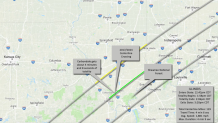A partial solar eclipse is set to round out the month of April, and though the sight won't be visible from Illinois, there are still ways to see it.
According to NASA, the partial solar eclipse on the evening of April 30 can be spotted amid clear skies in Chile, Argentina, most of Uruguay, western Paraguay, southwestern Bolivia, southeastern Peru and a small area of southwestern Brazil.
Along parts of the northwestern coastline of Antarctica, in the Atlantic Ocean off the southeastern coast of South America, including the Falkland Islands, and in much of the South Pacific Ocean and Southern Ocean, the eclipse will also be visible.
"A solar eclipse happens when the Moon moves between the Sun and Earth, casting a shadow on Earth, fully or partially blocking the Sun’s light in some areas. During a partial eclipse, the Moon and Sun are not perfectly aligned, so the Moon does not completely cover the Sun. This gives the Sun a crescent shape, or makes it appear as if a 'bite' has been taken out of the Sun, depending on how much of the Sun is covered by the Moon," NASA said on its website.
Feeling out of the loop? We'll catch you up on the Chicago news you need to know. Sign up for the weekly Chicago Catch-Up newsletter here.
Timeanddate.com will carry a free livestream of the partial eclipse next weekend here.
Hoping to spot an eclipse in Illinois?
On April 8, 2024, a total solar eclipse will take place. It'll be the last visible one from the U.S. until 2045.
Local
More 31 million people across 13 states — including Illinois — live in "the path of totality" for the event — meaning those places will see 100% totality.
According to the website nationaleclipse.com, in Illinois, the state of totality will begin on April 8, 2024 at 1:58 p.m. and end at 2:06 p.m.

In southern Illinois near Carbondale, the eclipse will be in the path of totality, meaning a total solar eclipse will be visible. The eclipse path map on timeanddate.com shows that in Chicago, the solar eclipse will only partially visible in Chicago, at 93.9%.
Check to see what the visibility will be in your city, here.
According to the Adler Planetarium, a solar eclipse can only occur at the New Moon Phase, when the arrangement in space is a line between the Sun, Moon, and Earth.
The moon, directly between the sun and Earth, casts a shadow on the planet, darkening the daytime sky. Those in the dark part of the moon’s shadow, the umbra, will experience a total eclipse, while those in the light part, the penumbra, will see a partial eclipse.
The period of totality refers to the time during a total eclipse when the moon completely obscures the sun. The period of totality is usually brief, lasting just a few minutes. Astronomy.com says the maximum period of totality for the April 8, 2024, solar eclipse is four minutes and 28 seconds.
The longest period of totality for the 2017 solar eclipse was quite a bit shorter, just about two minutes and 40 seconds, according to NASA.



